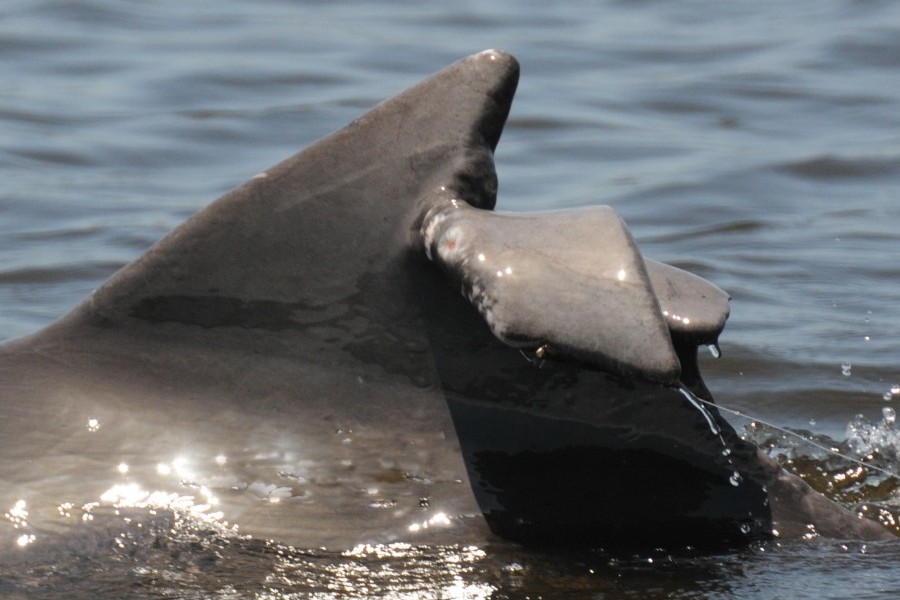Well-known dolphin “Riptorn” dies in Sarasota
Photo: Riptorn with fish hook caught in dorsal fin, with training fishing line, August 2015. Photo by Sarasota Dolphin Research Program, taken under National Marine Fisheries Service Scientific Research Permit No. 15543.
The most-recognizable dolphin in Sarasota Bay, Fla., died at age 43 and was recovered on Friday, Oct. 16, after living for decades with scoliosis and a dorsal fin sliced and bent by a boat propeller.
The carcass of the male bottlenose dolphin known to researchers with the Sarasota Dolphin Research Program (SDRP) as “Riptorn” was recovered Friday by Mote Marine Laboratory’s Stranding Investigations Program after a member of the public reported the dolphin floating south of Mote’s City Island campus. The carcass had been heavily scavenged by sharks. Mote staff conducted a necropsy (animal autopsy) Friday afternoon and further tests are under way to better understand the life and death of this unusual dolphin.
Riptorn, one of Sarasota Bay’s long-term resident dolphins, has been studied since 1980 by the SDRP, which conducts the world’s longest running study of a wild dolphin population. The Sarasota Dolphin Research Program (SDRP) is a program of the Chicago Zoological Society in partnership with Mote Marine Laboratory.
Scientists first identified Riptorn when he was a subadult. He was particularly recognizable because of the scoliosis that left his tail stock notably bent. He was observed 674 times in the wild, ranging primarily from Sarasota Bay to Venice and occasionally as far north as the Manatee River mouth.
In August 1983, his dorsal fin was sliced and folded from a presumed collision with a boat propeller, perhaps because his scoliosis impaired his ability to evade a strike. The wounds healed, but the disfigurement remained until his death, making Riptorn the most-recognizable dolphin in Sarasota Bay. While SDRP scientists usually identify dolphins by photographing subtle patterns of nicks and notches in their dorsal fins, Riptorn was hard to mistake.
“I could recognize him from my third floor office window, as he swam through New Pass,” said Dr. Randall Wells, Director of the SDRP. Wells encountered Riptorn many times over the decades, both during field research and during days off, when Wells kayaked near his home on Siesta Key.
“I’m surprised he lived this long, given everything he faced,” Wells said. “He’s a reminder of the ways human interactions can harm dolphins, whether we’re referring to his boat strike wounds or his entanglement in fishing gear and behavior around boats later in life.”
Riptorn interacted inappropriately with boaters and anglers, especially to seek food. Feeding wild dolphins is illegal and harmful, putting dolphins at risk of boat strikes and altering their natural foraging behaviors. Riptorn has been observed patrolling around recreational fishing boats, scavenging, removing bait or catch from fishing gear and even being fed by anglers on a few occasions. Though these encounters were relatively infrequent, he was observed interacting with anglers at least once each year since first being observed eating released fish from a recreational fishing boat in January 2005, indicating that angler interactions were likely a regular part of his foraging repertoire.
During August 2015, a hook and fishing line became attached to Riptorn’s damaged dorsal fin, causing him minor entanglement injuries before coming off on their own.
As of Oct. 19, Mote scientists are still investigating the circumstances of Riptorn’s death, but the preliminary necropsy has begun shedding light.
“The extent of the shark damage and the level of decomposition hindered our exam, but we were able to see that Riptorn had signs of lung and liver issues as well has some extensive lesions at the base of his tongue and through his esophagus,” said Gretchen Lovewell, Manager of Mote’s Stranding Investigations Program. “The extent of the scoliosis was greater than I had anticipated from seeing him free-swimming. We will be looking at his skeleton very closely once it is prepared.”
Riptorn’s skeleton will be archived for research at Mote in the Ruth DeLynn Cetacean Osteological Collection, which holds bones from more than 650 individuals of 17 species of cetaceans — dolphins, porpoises and whales. This scientific collection is available for researchers around the world. (More information here.)
Ruth DeLynn, the Mote volunteer and adjunct scientist who started the collection 30 years ago, passed away in 2014.
“Ruth was fascinated by Riptorn,” Lovewell said. “As it turns out, the day we recovered Riptorn would have been Ruth’s birthday. Like her, we’re all very interested to see his skeleton. We hope to keep learning more, and add to the significant records that already exist thanks to the Sarasota Dolphin Research Program’s work during Riptorn’s life.”
Over his life, Riptorn had several “buddies” – the strong male-male pair bonds discovered first for dolphins in Sarasota Bay, and subsequently found to be common at other dolphin research sites around the world. However, lately he was mostly alone, and paternity tests indicate that he had no offspring in the Bay. In contrast, other resident Sarasota Bay males have sired as many as six calves.
Riptorn’s physical problems did not prevent him from living a life that challenged expectations.
Wells said: “In spite of his physical limitations, we observed Riptorn engaging in activities we commonly see with uninjured dolphins. He frequently showed us that he was good at catching fish, in spite of missing many of his teeth, and we occasionally saw him riding in, and leaping from boat wakes. To survive in the wild, dolphins must become very good at compensating for, or masking, features that put them at a disadvantage. He succeeded in doing this over decades.”
Report distressed or dead marine mammals and sea turtles
If you see a stranded, entangled, injured or dead dolphin, whale, manatee or sea turtle anywhere in Florida, please call the FWC Wildlife Alert hotline at 888-404-FWCC FREE (3922). For marine mammals and sea turtles in Sarasota or Manatee county waters, you can contact Mote's Stranding Investigations Program, a 24-hour response service, at 888-345-2335.
